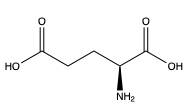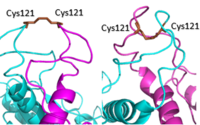Sandbox Reserved 1715
From Proteopedia
(Difference between revisions)
| Line 2: | Line 2: | ||
== Introduction == | == Introduction == | ||
| - | Within the central nervous system (CNS), various membrane receptors exist to detect extracellular signaling molecules and communicate this information intracellularly. Found in eukaryotes and known for its seven transmembrane helices, [https://en.wikipedia.org/wiki/G_protein-coupled_receptor G-protein coupled receptor] (GPCR) are one type of membrane bound receptors with conserved intracellular signaling via heterotrimeric G-proteins<ref name="Katritch">PMID:23140243</ref>. The metabotropic glutamate receptor (mGlu), a Class C GPCR, is a receptor utilized in glutamate signaling- which is essential in synaptic plasticity as well as the development and repair of the CNS. These receptors are specifically found in the pre- and postsynaptic neurons of the CNS. Eight different mGlu subtypes exist which are divided into three groups (I, II, III). While each mGlu has a slightly different function and location, the structures of the different mGlu subtypes are very similar (Table 1) <ref name="Niswender">PMID:20055706</ref>. For each group, binding of the neurotransmitter glutamate to the mGlu introduces a conformational change that can activate a G-protein. | + | Within the central nervous system (CNS), various membrane receptors exist to detect extracellular signaling molecules and communicate this information intracellularly. Found in eukaryotes and known for its seven transmembrane helices, [https://en.wikipedia.org/wiki/G_protein-coupled_receptor G-protein coupled receptor] (GPCR) are one type of membrane bound receptors with conserved intracellular signaling via heterotrimeric G-proteins<ref name="Katritch">PMID:23140243</ref>. The metabotropic glutamate receptor (mGlu), a Class C GPCR, is a receptor utilized in glutamate signaling- which is essential in synaptic plasticity as well as the development and repair of the CNS<ref name="Niswender">PMID:20055706</ref>. These receptors are specifically found in the pre- and postsynaptic neurons of the CNS<ref name="Niswender">PMID:20055706</ref>. Eight different mGlu subtypes exist which are divided into three groups (I, II, III)<ref name="Niswender">PMID:20055706</ref>. While each mGlu has a slightly different function and location, the structures of the different mGlu subtypes are very similar (Table 1) <ref name="Niswender">PMID:20055706</ref>. For each group, binding of the neurotransmitter glutamate to the mGlu introduces a conformational change that can activate a G-protein<ref name="Niswender">PMID:20055706</ref>. |
{| class="wikitable" style="text-align:center;" | {| class="wikitable" style="text-align:center;" | ||
Revision as of 19:08, 12 April 2022
| |||||||||||
3D Structures
7epa, mGlu Inactive
7mtr, mGlu Active
7mts, mGlu Active G Protein Bound
References
- ↑ Katritch V, Cherezov V, Stevens RC. Structure-function of the G protein-coupled receptor superfamily. Annu Rev Pharmacol Toxicol. 2013;53:531-56. doi:, 10.1146/annurev-pharmtox-032112-135923. Epub 2012 Nov 8. PMID:23140243 doi:http://dx.doi.org/10.1146/annurev-pharmtox-032112-135923
- ↑ 2.0 2.1 2.2 2.3 2.4 Niswender CM, Conn PJ. Metabotropic glutamate receptors: physiology, pharmacology, and disease. Annu Rev Pharmacol Toxicol. 2010;50:295-322. doi:, 10.1146/annurev.pharmtox.011008.145533. PMID:20055706 doi:http://dx.doi.org/10.1146/annurev.pharmtox.011008.145533
- ↑ 3.00 3.01 3.02 3.03 3.04 3.05 3.06 3.07 3.08 3.09 3.10 3.11 3.12 3.13 Seven AB, Barros-Alvarez X, de Lapeyriere M, Papasergi-Scott MM, Robertson MJ, Zhang C, Nwokonko RM, Gao Y, Meyerowitz JG, Rocher JP, Schelshorn D, Kobilka BK, Mathiesen JM, Skiniotis G. G-protein activation by a metabotropic glutamate receptor. Nature. 2021 Jun 30. pii: 10.1038/s41586-021-03680-3. doi:, 10.1038/s41586-021-03680-3. PMID:34194039 doi:http://dx.doi.org/10.1038/s41586-021-03680-3
- ↑ 4.0 4.1 4.2 4.3 Lin S, Han S, Cai X, Tan Q, Zhou K, Wang D, Wang X, Du J, Yi C, Chu X, Dai A, Zhou Y, Chen Y, Zhou Y, Liu H, Liu J, Yang D, Wang MW, Zhao Q, Wu B. Structures of Gi-bound metabotropic glutamate receptors mGlu2 and mGlu4. Nature. 2021 Jun;594(7864):583-588. doi: 10.1038/s41586-021-03495-2. Epub 2021, Jun 16. PMID:34135510 doi:http://dx.doi.org/10.1038/s41586-021-03495-2
- ↑ 5.0 5.1 5.2 5.3 5.4 Crupi R, Impellizzeri D, Cuzzocrea S. Role of Metabotropic Glutamate Receptors in Neurological Disorders. Front Mol Neurosci. 2019 Feb 8;12:20. doi: 10.3389/fnmol.2019.00020. eCollection , 2019. PMID:30800054 doi:http://dx.doi.org/10.3389/fnmol.2019.00020
- ↑ Bordi F, Ugolini A. Group I metabotropic glutamate receptors: implications for brain diseases. Prog Neurobiol. 1999 Sep;59(1):55-79. doi: 10.1016/s0301-0082(98)00095-1. PMID:10416961 doi:http://dx.doi.org/10.1016/s0301-0082(98)00095-1
- ↑ Conn PJ, Lindsley CW, Jones CK. Activation of metabotropic glutamate receptors as a novel approach for the treatment of schizophrenia. Trends Pharmacol Sci. 2009 Jan;30(1):25-31. doi: 10.1016/j.tips.2008.10.006. Epub, 2008 Dec 6. PMID:19058862 doi:http://dx.doi.org/10.1016/j.tips.2008.10.006
Student Contributors
- Courtney Vennekotter
- Cade Chezem




